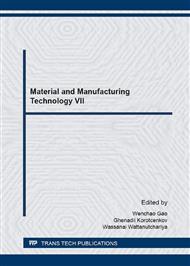p.50
p.55
p.62
p.67
p.73
p.81
p.87
p.92
p.97
An Effect of Friction Bonding Parameters to Delamination Defect
Abstract:
One of the advance adhesion methods is a friction bonding process which two or more materials are welded by a combination of heat and force to soften and attain an atomic adhesion between the two work layers. Using the insufficient heat and force, it can result in a delamination, which their layers do not completely sealed after the process. On the other hand, too much heat and force can result in an overflow of inserted aluminum and weak adhesive strength. This paper aims at revealing the effect of work temperature and force on the delamination defect. A blank stainless steel 430 with a dimension of 145 mm and 0.5 mm thickness is bonded with an Al 3003. The dimension of Al 3003 blank is 255 mm in diameter and 0.5 mm thickness. An aluminum 1100 with a diameter of 130 mm and 2.5 mm thickness is used as an adhesive bonding material between the stainless steel and the Al 3003 blank. The results showed that a reduction in defect rate can be obtained by increasing the work temperature as well as the stamping force. In addition, the optimal condition of the study case is also obtained through the experimental design. It can be concluded from the analysis that at voltage of 580 Volt which is equivalent to 470 C and force of 1,000 Tons is the optimal condition providing the least defect rate. The regression model was also developed to show the relationship of factors to the delamination size. This equation can be used to predict the mentioned delamination rate at various conditions.
Info:
Periodical:
Pages:
73-77
Citation:
Online since:
September 2016
Keywords:
Price:
Сopyright:
© 2016 Trans Tech Publications Ltd. All Rights Reserved
Share:
Citation:


